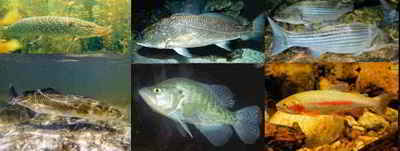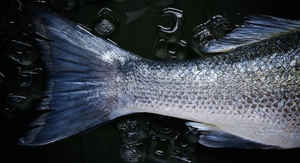
Tennessee Symbols
Tennessee State Sport Fish
Smallmouth Bass

(Micropterus salmoides)
Adopted on May 28, 2005.
The smallmouth bass bumped the largemouth bass from the Tennessee sport fish throne, ending a 17 year reign. The smallmouth bass became the official state sport fish when Governor Phil Bredesen signed SB1507 on May 28, 2005.
Before there was the smallmouth bass, there was the largemouth bass. Yes, on July 1, 1988, the largemouth bass was adopted as the official state sport fish of the State of Tennessee. It was the fifth state to claim the largemouth bass as its official representative..
In late 2003 the Tennessee Wildlife Resources Agency (TWRA) created a Tennessee Smallmouth Bass Management Plan "to identify the Tennessee Wildlife Resources Agency (TWRA)'s goals, objectives, and strategies for the management of smallmouth bass and its fisheries in the state of Tennessee."
On February 3, 2005, State Senator Doug Jackson introduced Senate Bill No. 1507 (SB1507) to the Tennessee State Senate. SB1507 proposed that the largemouth bass be replaced by the smallmouth bass as Tennessee's official state sport fish.
Bill sponsor Sen. Doug Jackson (D-Dickson) said the bill came at the urging of the Tennessee Wildlife Resources Agency (TWRA). It was proposed because the world's largest and second largest smallmouth bass were caught in Tennessee.
While a smallmouth bass can easily weighs 3-4 pounds, the state and world record is a whopping 11 pounds, 15 ounces. It was caught at the Dale Hollow Reservoir in 1955.
("Nashville City Paper")
Did you know that: Largemouth Bass has been proclaimed the official State Freshwater Fish in each of the following states
Alabama, Florida, Georgia, Mississippi, and Tennessee (Old).
Tennessee State Sport Fish: Smallmouth Bass

The smallmouth bass (Micropterus dolomieu) is a species of freshwater fish in the sunfish family (Centrarchidae) of the order Perciformes. It is the type species of its genus. One of the black basses, it is a popular game fish sought by anglers throughout the temperate zones of North America, and has been spread by stock to many cool-water tributaries and lakes in Canada and more so introduced in the United States. The smallmouth bass is native to the upper and middle Mississippi River basin, the Saint Lawrence River-Great Lakes system, and up into the Hudson Bay basin.
Other Common Names:
Its common names include smallmouth, bronzeback, brown bass, brownie, smallie, bronze bass, and bareback bass.
Characteristics of the Smallmouth Bass
Smallmouth bass is one of the most well known and sought after of the four species of black bass found in Tennessee. They prefer cool, clear water and are common in central and east Tennessee rivers, streams, and reservoirs. They are not native to, nor are they found, in the Mississippi River drainages of west Tennessee.
 Identification:
Smallmouth have small jaws that do not extend past the eye and a high bridge between the spiny and soft dorsal fins, two characters also common to
spotted and redeye bass. They have vertical bands of pigmentation on the sides, not the dark mid-lateral band of pigmentation seen with largemouth
and spotted bass. Smallmouth do not have the characteristic white margin on their soft dorsal, tail, and anal fins typical of redeye bass
Identification:
Smallmouth have small jaws that do not extend past the eye and a high bridge between the spiny and soft dorsal fins, two characters also common to
spotted and redeye bass. They have vertical bands of pigmentation on the sides, not the dark mid-lateral band of pigmentation seen with largemouth
and spotted bass. Smallmouth do not have the characteristic white margin on their soft dorsal, tail, and anal fins typical of redeye bass
Characteristics: The dorsal fin on the smallmouth bass is distinctly separated and contains nine to 11 spines and 13 to 15 rays. The anal fin has three spines and 10 or 11 rays. The bases of the soft dorsal and anal fins are covered with scales. The complete lateral line has 68 to 80 scales. The mouth is relatively large, with the upper jaw almost reaching the rear margin of the eye. The eye may have a reddish tint. Smallmouth bass lack the characteristic black stripe or jointed, lateral black blotches found on largemouth bass and spotted bass. Instead, the back and sides are bronze to olive green, with many irregularly spaced dark spots. The venter is generally white in small individuals, becoming dusky with age. Young smallmouth bass have several vertically oriented dark blotches along their sides that usually fade with age.
Life Cycle: Spawning occurs in April and May. Males usually build nests in gravel substrate in less than three feet of water. More than one female may spawn in the nest of a single male. The males guard the eggs and fry until they disperse.
Adult: 15 to 20 inches (380 to 508 mm). The state angling record (10 lb, 8 oz) was caught in the Tennessee River below Wheeler Dam in 1950.
Distribution: Smallmouth bass are native to the Tennessee River drainage. They have been unsuccessfully introduced into Lake Lewis Smith (Black Warrior River) and the Cahaba, Coosa, and upper Tombigbee rivers. A sub-page shows the Alabama distribution and shows a United States map including only the native range of this species.
Habitat: Smallmouth bass inhabit clear, small to medium-sized streams, rivers, and reservoirs. They favor such underwater structures as rock outcrops, logs, treetops, and constructed riprap walls. Spawning usually occurs in April and May, when water temperatures reach 59° to 63°F (15° to 18°C) (Hubbs and Bailey, 1938). Smallmouth feed primarily on small fishes, crayfishes, and insects (Hubert, 1977). Carlander (1977) reports life spans of six to 14 years in southern and northern populations.
Tennessee Law
The law designating the small-mouth bass as the official Tennessee state sport fish is Section 4-1-317 ( State sport fish) of the Tennessee Code, Title 4 (STATE GOVERNMENT) Chapter 1 (GENERAL PROVISIONS) Part 3 (STATE SYMBOLS) Section 4-1-317.
TITLE 4. STATE GOVERNMENT.
CHAPTER 1. GENERAL PROVISIONS.
PART 3. STATE SYMBOLS.
Section 4-1-317
4-1-317. State sport fish. -
The small-mouth bass is hereby designated as the official state sport fish.
[Acts 1988, ch. 489, § 2; 2005, ch. 277, § 1.]
Taxonomic Hierarchy: Small-mouth Bass
Kingdom: Animalia - animals
Phylum: Chordata - chordates
Subphylum: Vertebrata - vertebrates
Class: Actinopterygii - ray-finned and spiny rayed fishes
Subclass: Neopterygii
Order: Perciformes, perch-like fishes
Suborder: Percoidei
Family: Centrarchidae
Genus: Micropterus
Species: Micropterus dolomieu







